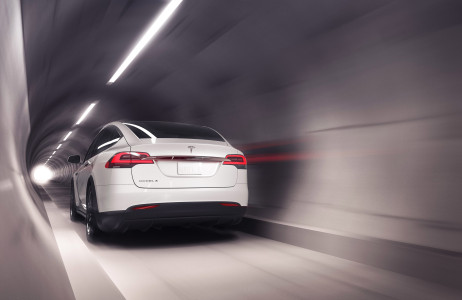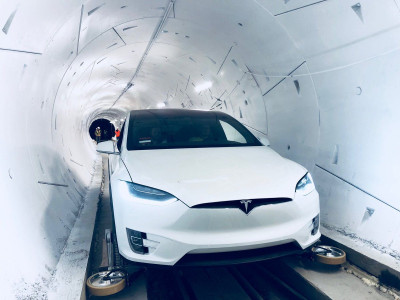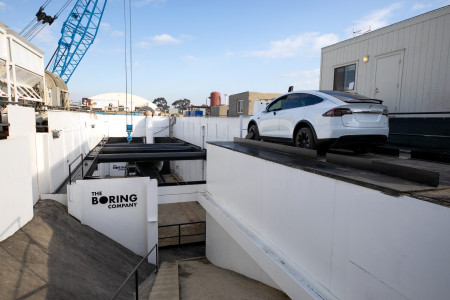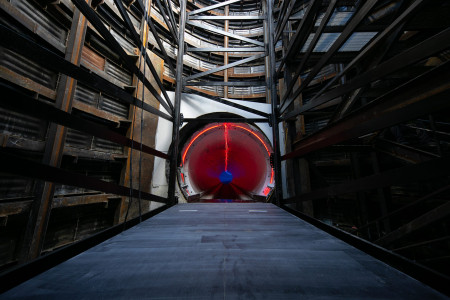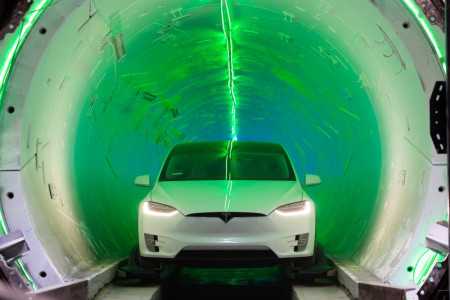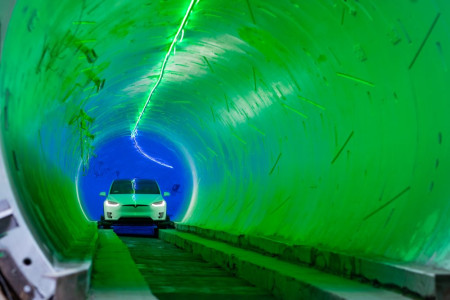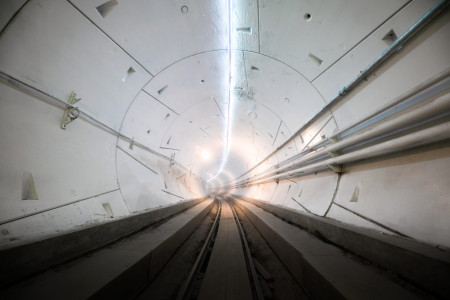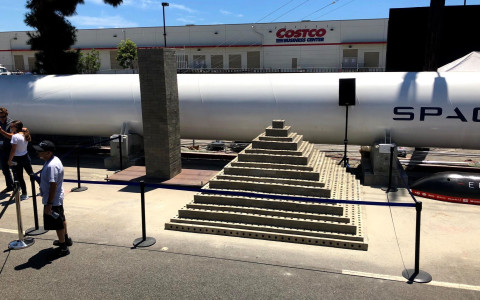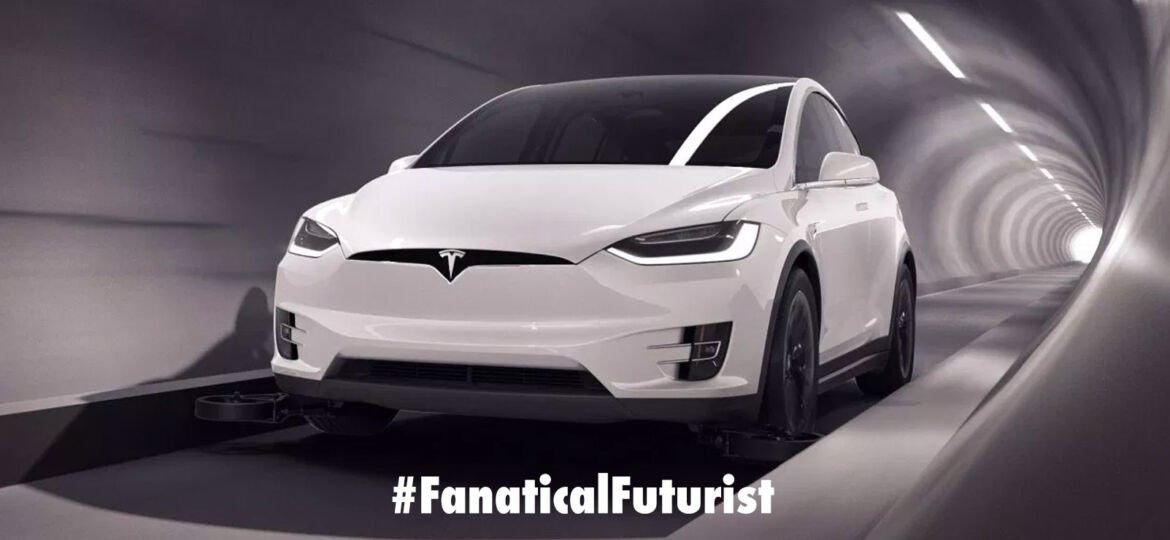
WHY THIS MATTERS IN BRIEF
Urban transportation is often a nightmare of clogged and congested roads, Musk believes he has a solution, and it’s going underground.
Elon Musk unveiled his vision for the Boring Company last night with the unveiling of the company’s first 12 ft wide test tunnel segment in Los Angeles, and as I predicted on the Discovery Channel back in 2017 not only is he planning on developing a system of tunnels beneath Los Angeles to solve it’s “travel chaos” but he’s also planning on using the same technologies to make Mars habitable. When he gets there.
At one point he fantasised about building “infinite real estate underground” on Mars whose surface is pretty much uninhabitable because of the huge amounts of radiation.
“I hope we’re one day building tunnels on Mars,” he said. “That would be a glorious day.”
For now though back on Earth it appears that Musk has abandoned his “electric skate” plan, shown in the below concept video from earlier this year, and replaced it with more “traditional” autonomous electric vehicles, starting with Tesla vehicles that use tracking wheels to keep them straight in the tunnels.
There are two main parts to the Boring Company and its mission to reduce traffic in metropolitan areas, firstly to improve the technology of making tunnels cheaply and quickly, and secondly to develop a fully electric and autonomous transport system that works well inside those tunnels. And the biggest announcement last night was to do with the second part, the transportation system.
Previously the company had been talking about building electric skates on which vehicles could park themselves and be whisked off through the tunnel network, and then after that the company was planning on using electric pods as public transportation.
Last night Musk announced that they are dropping both of those ideas, for now at least, in favour of a system of “tracking wheels”, which can be installed as an attachment to vehicles that deploy from underneath the vehicle to act as a guide to keep the cars from hitting the side of the tunnel. In a press briefing ahead of the event Musk said the system could be added to a vehicle during the configuration for “$200 to $300.” He also said that it could be installed as an aftermarket product. Musk even said that it could be installed on vehicles other than Tesla’s, though for now they’re using the Model X.
“We used Tesla vehicles because I run Tesla. What I am going to do? Use someone else’s car?” he said.
Although that said at the moment there are several restrictions for a vehicle to be used in the Boring Company’s tunnels that it basically makes Tesla vehicles the only eligible ones at this point.
These include the fact that they need to be electric, in order to eliminate the risks of vehicle exhaust fumes, be able to maintain a speed of around150 mph, and have some autonomous capabilities which translates into a minimum requirement to at least be able to accelerate and brake autonomously.
The Boring Company had Model X SUVs on hand to give test rides to the press, but they weren’t equipped with the final design of the tracking wheels. They weren’t retractable, which makes them impractical on the road but they did their job well enough in the tunnel and during the demonstration.
While the wheels basically convert the Model X into a train, journalists at the event said it was a surprisingly bumpy ride, which the company attributed to some experimentation with the “shelves” on each side of the tunnel.
The Model X drives on those shelves, which consist of concrete sections placed on each side to support the vehicle.
The company is still experimenting on how to produce and install those concrete sections as fast as possible but they clearly haven’t quite figured it out yet because some of the sections were lot bumpier than others with Musk insisting that it will be an easy fix and once it is done, the rides will be “as smooth as glass.”
Following the launch event, not much has changed on the tunnel boring technology front. The company says that it learned a lot from its first test tunnel in Hawthorne and it is working on its next generation boring machine.
They dug ‘Godot’, their first machine, out of the test tunnel and they are now working on ‘Line-Storm’ but ‘Line-Storm’ is not the final product. They also have a third-generation boring machine called ‘Prufrock’.
For that machine, they are working to increase the power of the machine by a factor 3, modify the cutter design, and add an automated segment erection system.
In a brief with the press prior to the event, Musk said existing tunnel boring companies spend only about 10 minutes mining per hour as the rest is spent installing the reinforcement and deploying all the logistics behind – power, dirt removal, etc.
They see a potential 15x improvement in the speed of boring versus the next best boring technology by engineering a system that automatically takes care of that at the same time as they dig, and Musk said that he expects this new system to be ready “relatively soon”.
Another big part of their plan to reduce the cost of boring the tunnel is to change the economics of moving the dirt, which can represent up to 15 percent of the total cost of a tunnel. Instead of moving the dirt costing them money, they plan to sell them to make kits for structures. Musk gave several examples from ancient Egypt, like the pyramids, Sphinx, and the temple of Horus. Naturally.
Musk claimed that the bricks are more solid than cinderblocks and he suggested that the company could sell them for just 10 cents in order to get rid of the dirt. They also want to offer them for free to build affordable housing.
At the launch event, for example, the Boring Company built an actual full-size watchtower with brick made of the dirt dug out of the Hawthorne tunnel. The Boring Company is betting that the combination of going faster, reducing the diameter of the tunnel, and better economics of managing the dirt will result in drastic reduction in the cost of tunnelling.
Where most projects cost over $1 billion per mile and take 3 to 6 months per mile, the Boring Company plans to do it for a fraction of the time and the cost. Musk said that the 1.14 mile test tunnel in Hawthorne cost them only about $10 million and they have yet to implement most of their cost and time saving ideas. And the mission of the company remains the same – to reduce “soul destroying traffic.”
In the long term, Musk wants the company to deliver giant networks of tunnels with many layers and main “highway” tunnels acting as a loop with several “exits” leading to stations to get back to the surface.
The only time vehicles slow down is in those exits in order to maintain the 150 mph top speed in the main tunnels and the plan is that vehicle drivers will be able to use the new tunnel network as superhighways for a small fee, which Musk says could be just $1. The Boring Company plans to also have its own fleet of Tesla vehicles operating inside those tunnels to act as public transport.
Musk said that he expects the Chicago project will be the first full loop that the public will be able to use, and they are also still working on the “Dugout loop project” in Los Angeles that will connect Hawthorne with the LA Dodgers Stadium, which they hope will eventually be part of a much larger LA tunnel system.
Musk also said that money won’t be an issue for the company as he’s currently personally bankrolling it, but said he’s been flooded with request to invest, despite the fact that he hasn’t got a solid business plan for the company yet. On top of investment requests, he said that municipalities are also inquiring about future potential projects such as one in Las Vegas, and they’re in the early stages of construction on the east coast hyperloop.
In the near future I also expect more announcements about Musk’s plans to install a Hyperloop, a Mach 1 train, in the tunnels which again will no doubt have a big impact on urban traffic chaos, especially on longer journeys across, or even between, cities – something that Dubai has been eyeing up too after it penned a $50million deal with Hyperloop Transportation Technologies last year.

